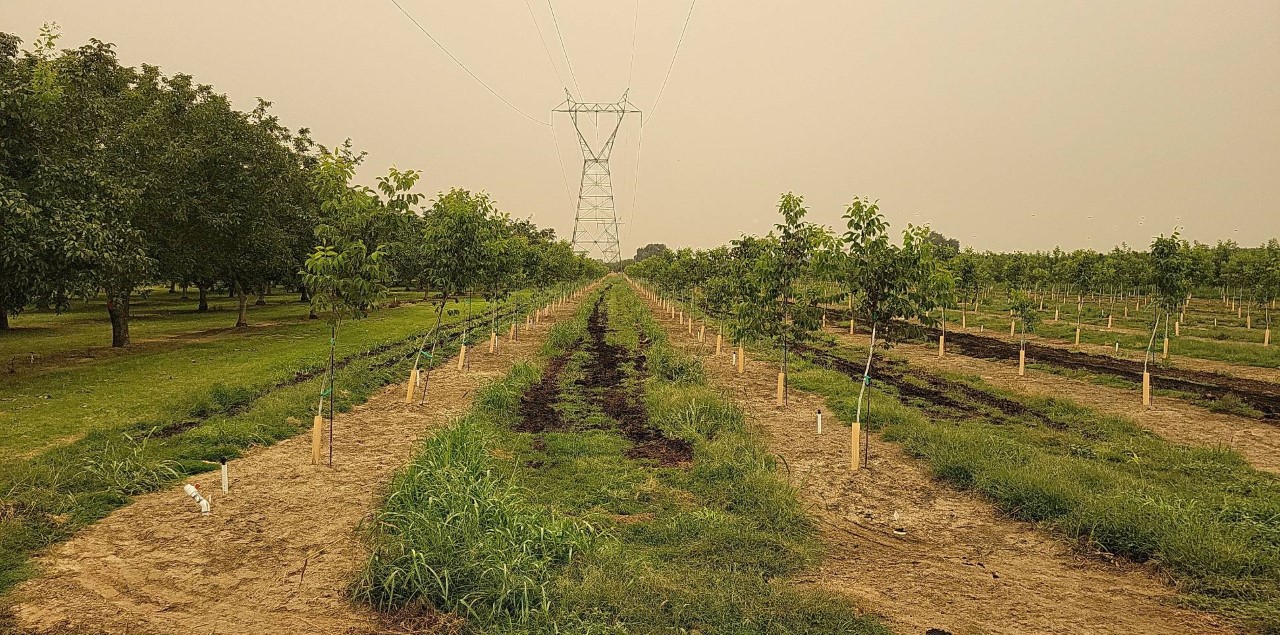
When it comes to planting a new walnut orchard, growers and farm managers throughout California’s walnut growing regions have a wide range of choices. In addition to rootstock and variety, decisions are made on planting bare root, potted or finished bare root trees. Another round of decisions is required for tree establishment and training the first year the trees are in the ground.
There are University of California guidelines for training walnut trees from planting to first leaf, there are tree nursery recommendations for orchard establishment and there are innovations in tree training methods.
“There are hundreds of opinions on what should be done to a tree in the first year,” Cliff Beumel from Agromillora Nursery in the Sacramento Valley said. “You have to take plant physiology into account.”
Tom Burchell with Burchell Nursery in Oakdale concurs that there are different opinions on tree training, but the focus should be on establishment of a strong tree that will be productive over the years.
“There is a product for all preferences,” said Reid Robinson of Sierra Gold Nursery. “Production and economics are part of the decision.”
What Goes in the Ground?
The main nursery products for walnut orchards are bare root rootstocks, potted rootstocks and bare root finished trees on clonal Paradox rootstock. The rootstocks can either be grafted in spring after planting, fall budded, or grafted the following spring.
Katherine Jarvis-Shean, UCCE orchard systems advisor in Solano, Yolo and Sacramento counties, said finished bare root trees have the advantage of more wood and growth versus potted trees when they are planted. Bare root trees do have a larger root system than potted trees, and that makes them easier to manage in terms of irrigation. It is not always true that bare root trees outgrow potted trees, Jarvis-Shean noted.
Growers will choose to plant potted trees even though they need more attention in regards to irrigation.
“It takes a lot of art and science to bring potted trees along,” Jarvis-Shean noted. They have a small volume of soil that needs to be recharged. “Getting water to three feet of roots is easier than the six inches of roots on a potted tree. They are less forgiving.”
She noted that one reason why growers might choose to plant potted trees is that they would not be bringing in any crown gall to the orchard site. Crown gall can still get into an orchard, she stressed, but potted trees are far more likely to be free of this pathogen when they arrive for planting.
At planting, UC guidelines recommend cutting back rootstocks to between 15 to 30 inches in height. Once grafted or budded to a variety, a single leader should be selected and side shoots pinched or cut back.
Clonal rootstocks are known to be vigorous and pushing with water or fertilizer is discouraged. Planting potted rootstock and fall budding or grafting the following spring adds an additional year in the training process, compared with finished trees.
Bare root finished trees on seedling or clonal Paradox rootstock can be June budded with one year of scion growth in the nursery or nursery grafted with one year of rootstock growth and one year of scion growth in the nursery. UC guidelines recommend at planting to cut back to three to six good buds above the graft or bud union.
Robinson said he prefers a conventional bare root June budded tree, one that has had a year of growth in the nursery and a good root system. Potted trees, Burchell noted, have an advantage in northern growing areas where planting in the winter is not an option. These trees can go in during early fall and establish roots before the dormant season.
Training Options
When it comes to training young walnut trees, Jarvis-Shean said more growers are getting on board with “no-pruning” unheaded trees.
The tree grows a central leader that is not topped and buds are not removed. The next year as branches form, they are allowed to grow unless they look unsound.
“Bruce Lampinen’s research showed these trees yield earlier and have better structure over the long haul,” Jarvis-Shean said. Growers also have considerable savings in pruning costs during tree establishment.
A decade ago, UC also began researching leaving finished trees unheaded or high headed to increase early yields. Trials at UC Davis and grower orchards showed trees left unheaded after planting were comparable or better in growth than those cut back to three to six buds. Trees left unheaded grew at a slower pace initially but had fewer issues with bending in the wind.
More recent trials showed tall, finished walnut trees grow well when left unheaded. Primary scaffolds can be produced during the first leaf growing season from preformed buds. These buds are normally removed by heading at planting in the traditional training method.
Development of root system and girth are predictors of performance, Beumel said. Cutting off branches decreases the tree’s ability to maximize size and its capacity to photosynthesize.
“Let the tree grow biomass.” Beumel said. “Cut as little as possible.”
Robinson said in his experience, there is a wide range of tree training practices among growers. Some will top at 8 to 10 feet to push laterals, but a lot don’t like to keep branches. Some let them go. There is a wide divergence in practices, he added.
After planting, Robinson said the goal is to get to a reasonable height.
In the Sierra Gold orchards, he said they follow the no-prune guide from UC. Not only do they save on labor costs, but the trees develop well and are productive early. There are some differences between varieties in the way they respond to the no-prune system.
“We’ve have some problems, as with any system, but we’ve learned to work through them and it’s what we are going to be using going forward,” Reid said.















